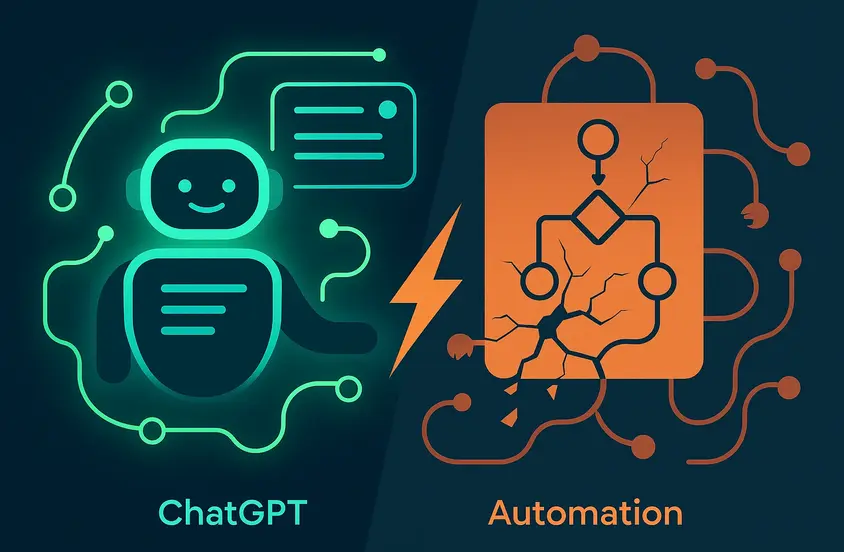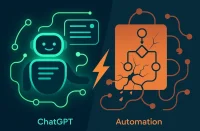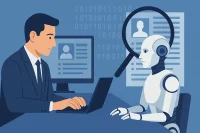ChatGPT kills Zapier represents a revolutionary shift in AI automation that threatens to disrupt the entire workflow automation industry. OpenAI’s latest releases include direct app integration within ChatGPT and Agent Kit, a visual workflow builder that makes it simple for anyone to create sophisticated automation without leaving the ChatGPT interface.
This disruption comes at a time when companies like Zapier, Make.com, and other automation platforms have built entire businesses around connecting different apps and services. ChatGPT’s new capabilities essentially eliminate the need for these intermediary tools by providing native integration and automation directly within the AI interface.
Table of Contents
What Makes ChatGPT Kills Zapier Different from Previous AI Disruptions
This represents a fundamentally different type of disruption compared to previous AI innovations. Unlike incremental improvements or new features, this represents a complete paradigm shift in how users interact with and automate their digital workflows.
The integration is seamless and native, requiring no external connections or complex setup processes. Users can simply mention an app with the @ symbol and ChatGPT automatically connects and uses that service, making automation accessible to everyone regardless of technical expertise.
This approach eliminates the barrier to entry that has traditionally limited automation adoption, potentially making sophisticated workflows available to millions of users who previously found automation tools too complex or expensive.
Direct App Integration Within ChatGPT
The new app integration feature allows users to interact with popular services directly within ChatGPT without ever leaving the interface. Users can create Spotify playlists, design graphics in Canva, book hotels through Booking.com, or generate documents in Figma – all through natural language commands.
The integration works by simply typing “@” followed by the app name, and ChatGPT automatically connects to the service. This creates a much more intuitive experience compared to traditional automation tools that require complex setup and configuration.
The built-in apps include major services like Spotify, Canva, Figma, Booking.com, Expedia, and Zillow, with many more coming soon including DoorDash, Instacart, OpenTable, Target, and Uber.
Agent Kit: Visual Workflow Builder
Agent Kit represents OpenAI’s answer to visual workflow builders like Zapier, Make.com, and Mind Studio. This tool provides a node-based interface for creating multi-agent workflows that can be embedded within apps and websites.
The system leverages Model Context Protocols (MCPs), allowing any app on the internet to create their own MCP server and integrate with the Agent Kit workflow builder. This creates an infinitely scalable ecosystem where virtually any tool can be connected.
Agent Kit includes features like file search, guardrails for content moderation, if-else statements for conditional logic, and the ability to connect to various MCP servers for comprehensive automation capabilities.
The Threat to Traditional Automation Platforms
By providing a more integrated and user-friendly alternative to traditional automation platforms. The native integration eliminates the need for complex setup processes and external connections that have traditionally been barriers to automation adoption.
The visual workflow builder in Agent Kit directly competes with established platforms like Zapier, Make.com, and Mind Studio, but with the advantage of being built into the most popular AI platform in the world.
The threat is particularly significant because ChatGPT can recommend tools to users and make the integration process seamless, potentially capturing market share from established automation platforms.
The Developer Ecosystem and Monetization
OpenAI has announced plans to roll out monetization for app developers whose tools get integrated and used frequently within ChatGPT. This creates an incentive for developers to build apps specifically for the ChatGPT ecosystem.
The company has also released an SDK (Software Development Kit) to help developers create apps that work natively within ChatGPT, potentially creating a new ecosystem of integrated applications.
This approach could lead to a more centralized automation ecosystem where ChatGPT becomes the primary platform for AI-powered workflows, similar to how the App Store revolutionized mobile applications.
The MCP Protocol and Scalability
The Model Context Protocol (MCP) represents a key innovation that allows any app to integrate with ChatGPT’s automation capabilities. This protocol makes it possible for virtually any service to connect with the AI platform, creating unlimited possibilities for automation.
As more companies develop MCP servers for their products, the automation capabilities within ChatGPT will continue to expand, potentially making it the most comprehensive automation platform available.
The protocol also ensures that the automation ecosystem remains open and not limited to OpenAI’s own services, allowing for true interoperability between different platforms and services.
The Future of AI Automation
The Model Context Protocol (MCP) is transforming ChatGPT into an open automation platform with limitless integration potential. Employers can get ahead of this revolution by hiring developers, engineers, and AI specialists ready to build the next generation of automation. Post your job on WhatJobs today and connect with top talent eager to shape the future of interoperability and AI-driven workflows.
Post a Job Free for 30 Days →The Impact on Small Businesses and Entrepreneurs
By making sophisticated automation accessible to small businesses and entrepreneurs who previously couldn’t afford or didn’t have the technical expertise to use complex automation tools.
The natural language interface eliminates the learning curve associated with traditional automation platforms, allowing users to create workflows simply by describing what they want to accomplish.
This democratization of automation could lead to significant productivity gains for small businesses and individual entrepreneurs who can now access enterprise-level automation capabilities.
The Future of AI Automation
The ChatGPT automation features represent just the beginning of what’s possible with AI-powered workflows. As the technology continues to evolve, we can expect to see more sophisticated automation capabilities and deeper integration with various services.
The natural language interface could eventually allow users to build complex workflows simply by describing their needs, eliminating the need for visual workflow builders entirely.
The integration with MCP servers creates a foundation for an ecosystem where any app can be automated and connected, potentially revolutionizing how we interact with digital services.
The Competitive Landscape
This means a more integrated and user-friendly alternative, but traditional automation platforms still have advantages in terms of model flexibility and integration breadth.
Platforms like Zapier and Make.com allow users to choose from multiple AI models and integrate with a wider range of services, while ChatGPT’s automation is currently limited to OpenAI’s models.
The competition between these platforms will likely drive innovation and improve the overall automation ecosystem, benefiting users regardless of which platform they choose.
Frequently Asked Questions
What does ChatGPT kills Zapier mean for the automation industry?
This represents a revolutionary shift where OpenAI’s new app integration and Agent Kit features eliminate the need for traditional automation platforms by providing native workflow automation directly within ChatGPT’s interface.
How does ChatGPT kills Zapier differ from previous automation tools?
This differs by providing seamless native integration through natural language commands, eliminating complex setup processes, and making sophisticated automation accessible to users without technical expertise through the @ symbol app integration.
What are the key features that make ChatGPT kills Zapier a threat to traditional platforms?
Key features include direct app integration within ChatGPT, visual workflow builder Agent Kit, Model Context Protocol for unlimited app connections, natural language automation commands, and planned monetization for developers creating integrated apps.
How can businesses adapt to the ChatGPT kills Zapier disruption?
Businesses can adapt by leveraging ChatGPT’s new automation capabilities, developing MCP servers for their products, focusing on unique value propositions that complement AI automation, and exploring opportunities within the new ChatGPT ecosystem.
A Real-World Example: Sarah’s Automation Transformation
Sarah Martinez, a 28-year-old marketing consultant from Austin, exemplifies how ChatGPT kills Zapier can transform business operations. After years of struggling with complex automation tools and expensive Zapier subscriptions, Sarah was looking for a more intuitive way to automate her client workflows.
“I had been using Zapier for years, but I was constantly hitting the limits of my plan and struggling with complex setup processes,” Sarah explains. “When I discovered ChatGPT’s new automation features, I was immediately excited because it promised to make automation accessible without the technical complexity.”
Sarah’s journey with ChatGPT automation began when she started using the direct app integration features to create content and manage client projects. She was particularly attracted to the ability to generate graphics in Canva and create Spotify playlists for client campaigns without leaving the ChatGPT interface.
“The integration was seamless,” Sarah says. “I could create a complete marketing campaign by just talking to ChatGPT. It would generate the graphics, create the content, and even set up the social media posts. ChatGPT kills Zapier by making this process so much simpler and more intuitive.”
Within three months of using ChatGPT’s automation features, Sarah had significantly reduced her reliance on external automation tools and increased her productivity. She was able to serve more clients with the same amount of time and create more sophisticated workflows than ever before.
“ChatGPT kills Zapier taught me that automation doesn’t have to be complex,” Sarah reflects. “The natural language interface and native app integration showed me that I could create powerful workflows just by describing what I wanted to accomplish. It’s not just about replacing Zapier – it’s about making automation accessible to everyone.”




